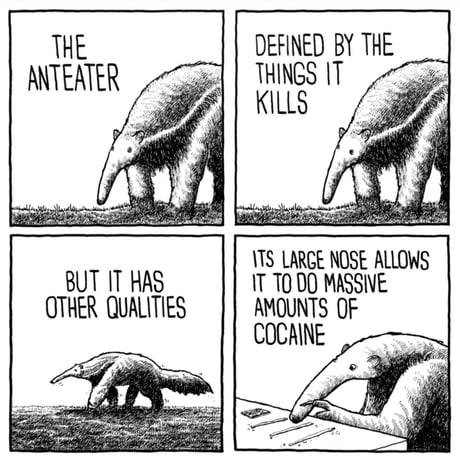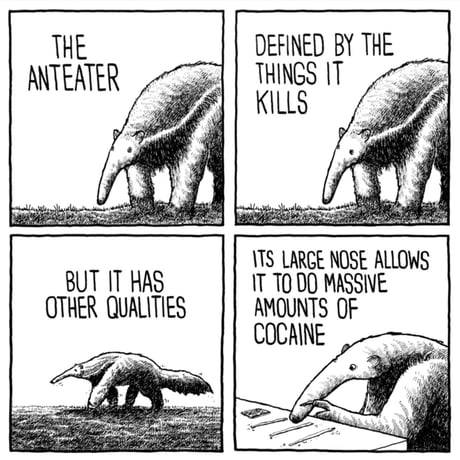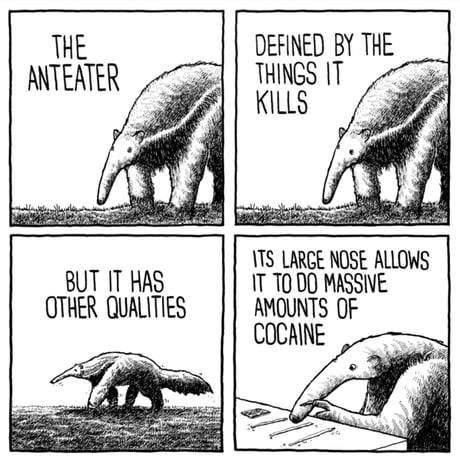#noodlenose
Text
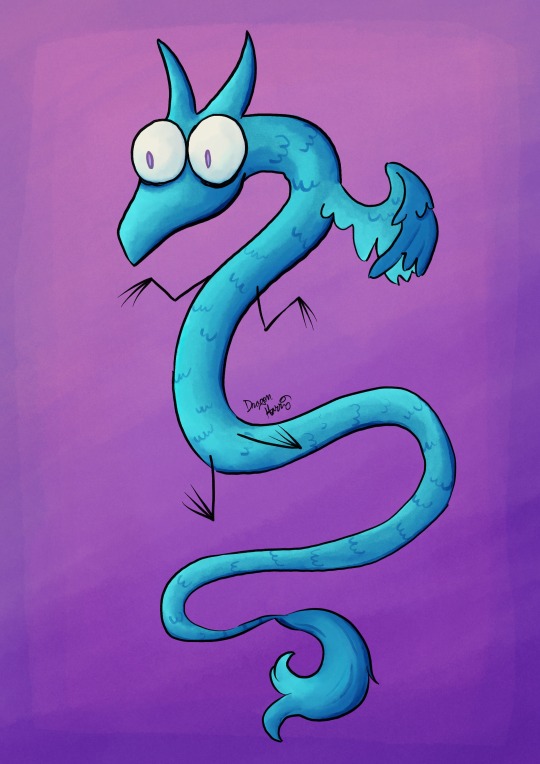
Here is a dragon, I shall call her Noodlenose.
3 notes
·
View notes
Text
The Early Temperocene: 145 million years post-establishment

Reaching Snout A Hand: Rhinocheirids of the Early Temperocene
The rhinocheirids are an unusual lineage of the walkabies that, after arising in the Therocene as an insular offshoot on the continent of Fissor, are highly remarkable for their dexterous trunks: a far cry from the stubby tapir-like snouts of other, more basal walkabies. Theirs are long and pliable and sport three lobes at the tips, formed from the nose and split upper lip of their ancient rodent forebearers-- an appendage that allowed them to access unusual ecological niches, procure food, and even, at one point, use tools: an advancement cruelly cut short before it could reach its full potential.
Gone now are the fisshors of the Glaciocene, and their brief glimmer of awareness in the splintsters. But still, the rhinocheirids are far from a dying clade: they are thriving, and diversifying, in the lush new landscapes the Temperocene has to offer them. Here, on the planet's western hemisphere, the rhinocheirids thrive, across Gestaltia, Austro-Easaterra, and the neighboring islands, such as the nearby Fissorian Archipelago.
Some of the most unusual of the rhinocheirids are the treebumms: small, arboreal omnivores that feed on fruit, insects and seeds, they in essence fill a niche similar to those of the lemunkies of Arcuterra and South Ecatoria, yet their appearances could not be more different. Their forelimbs are small and reduced to but a single claw, a holdover from the time their ancestral forelimbs began to dwindle as their trunk became more dexterous, and while they still are used for holding onto food while swinging from the trees, much of their locomotion is derived from their prehensile tails, grasping hind feet, and their powerful trunks, all of which possess incredible flexibility that make them the aces of the treetops. Their trunk, in particular, contains rings of cartilaginous support, giving it extra strength that allow them to even support their whole weight on a branch, though only for a few seconds at most as, due to this "limb" containing its nasal passages, causes some discomfort to suspend the creature's mass of up to four kilograms at the most.
Most, such as the slender noodlenose (Pithecorhinocheirus uninyx) are highly-active and sociable animals, swinging from tree to tree with their unusual array of appendages in search of food and shelter, and use their superior flexibility to evade predators and outspeed them in the trees. On the Fissorian Archipelago, however, with a relative absence of dangers and few native carnivores, the local treebumms have adopted an opposite way of life, seen in the black-bellied vertigoth (Tardirhinocheirus nigraventrus), a slow-moving herbivore that clambers ever so sluggishly in the canopy. With fruit so far between, much of its diet is of poor-nutrient leaves, and spends so much time hanging upside down that its countershading has entirely inverted, with a dark belly and a light back. Its only predators aerial ones, their primary mode of defense is camouflage, moving so slow that they can barely be seen in the irregular shadows of the canopy.
Throughout most of Gestaltia and Austro-Easaterra, however, the dominant rhinocheirids are ground-dwelling and far larger, weighing up to half a ton in the largest species, certainly far too heavy to climb any tree. The forest magnose (Novamagnorhinocheirus spp.) is found on both continents, with a Gestaltian species (N. vulgaris) and an Austro-Easaterran species (N. australis), both of which are large foragers, primarily herbivorous and browsers yet take some animal protein in the form of insects or carrion on occasion. However, it is only on Austro-Easaterra, in the absence of Gestaltia's towering altolopes, that one can find the respective high-browser, the blotched treecher (Neoaltorhinocheirus pardus), towering at a height of nine to ten feet with its long legs and long neck, a reach further extended by the reach of its slender trunk to pluck the leaves from the highest branches out of range of other herbivores on the continent. The treechers prefer open plains with sparse conifers, one of the predominant trees of Austro-Easaterra as a holdover from the Glaciocene, and grinding teeth and a powerful fermenting stomach, they can consume conifer branches, leaves and cones, as well as the broadleaf trees whenever they are available. These browsers are highly adaptable, being rather intelligent creatures, and learned behaviors such as shaking down especially tall trees to dislodge loose branches and cones are often mimicked by younger members of their herds.
And it is also here in Austro-Easaterra that one group of rhinocheirids would take an opposite direction in their evolutionary paths: they would become carnivores, though mostly only as mesopredators in an ecosystem dominated by the bearhounds, large zingos that, in more recent ages, have been slowly displaced by the blubbears of Peninsulaustra as the two continents collided in the Temperocene. Small forms would be primarily insectivorous and small-scale hunters of furbils, rattiles and other bite-sized prey. The most specialized of these, the myrmic quilltail (Echinorhinocheirus myrmecophagous), is the smallest of the graptors, a group of mostly heron-like hunters. Quilltails, however, feed mostly on insects under logs or stones or nesting in dead wood, which it accesses using its sharp singular claws and trunk, to uncover bugs that can in turn be scooped up by its long tongue. It is, however, not a complete myrmecophagous specialist, and on occasion will raid carrion and the kills of larger predators. Notable are the sharp spiny quills covering its tail that act as an extra line of defense, as being a small carnivore makes it many enemies, with larger carnivores viewing it as a competitor, especially when it boldly tries to rob them of a morsel before fleeing, their prickly tail deterring any pursuers.
However, in this ever-comoetitive environment forged from two isolated landmasses fused into one, one carnivorous rhinocheirid had slowly been muscling its way to the top: the lipgrips, characterized by their greatly reduced trunks, but powerful nasal lobes, which in junction with their prehensile lower lip acts almost like a powerful gripping "hand" that lets them deliver lethal bites to larger prey: the biggest extant species, the seven-foot-long throttling lipgrip (Manucephalovenator gnathodactylus), is well-equipped to tackle tetracorns, oingos, blubbats and even other rhinocheirids with its powerful grappling bite. Indeed, with the mutual decline of the bearhounds and the blubbears due to competition in the collision of the two landmasses, the lipgrip has risen to prominence as the new continent's apex predator, with blunt claws on its feet for traction in running down prey, hooked ones on its hands for securing its quarry in a deadly embrace, and sharp, cutting incisors for severing the spine with a bite at the back of the neck, or the vital arteries of the neck, for a quick or even instantaneous kill. Lipgrips are typically pair-bonded creatures that hunt cooperatively as mated pairs, occupying a territory together that the pair proclaim to potential rivals with a distinctive call-- a deep, reverberating grunt coupled with the almost comically raspberry-like flapping of their nasal lobes that seem almost unfittingly dissonant coming from such a fierce and intelligent hunter.
---------
89 notes
·
View notes
Text
Problem Sleuth, page 1,617
Next.
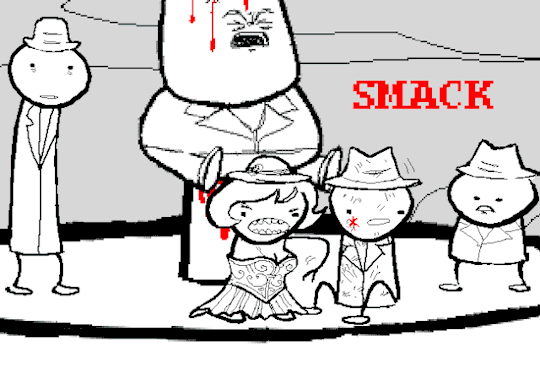
No it wasn't a dream! Quit bumpin' gums, ya noodlenosed loon!
Now prop your lazy bones on those getaway sticks and shake a leg, mister! Everyone get in the flivver or this trip's for biscuits, see??
Author commentary: PROHIBITION ERA SLANGTECH: GAIN ALL LEVELS!
0 notes
Text

noodlenose hits the town
#silken windhound#sorry school has been KICKIN my ass so i have been inactive here#but i finished the quarter today!!!! so i will try to be on more :)#go head wit yo broken leg ass
13 notes
·
View notes
Video
Getting to "nose" you Is that water coming out of the elephant's trunk? . . . 'Snot #myjobisbetterthanyours #Tonkao #babyelephant #elephants #ethical #ecotourism #elephant #trunk #noodlenose #closeenoughtocare #mahout #6monthsold #babyanimals #elephantsofinstagram #phangngaelephantpark #thailand #travel #puns #zoopuns #zoolife
#elephantsofinstagram#6monthsold#babyanimals#closeenoughtocare#zoolife#tonkao#elephants#babyelephant#mahout#phangngaelephantpark#travel#puns#noodlenose#trunk#ethical#myjobisbetterthanyours#elephant#zoopuns#thailand#ecotourism
0 notes
Text
noodlenose replied to your photoset “my prescription changed so i got new glasses! ��”
and your eyes are an amazing colour!!
thank uuu <3
0 notes
Photo

#noodlenose #noodle #sirashton #whippetsofinstagram #whippet #im3 #toocuteforhisowngood #makesmyheartsmile #lovehim #littlebrother #dogsofinstgram #dogoftheday #picoftheday #instaoftheday #thekolinofskys (at Dallas, Texas)
#makesmyheartsmile#noodle#sirashton#thekolinofskys#noodlenose#whippet#im3#toocuteforhisowngood#dogsofinstgram#littlebrother#lovehim#instaoftheday#picoftheday#whippetsofinstagram#dogoftheday
0 notes
Photo

No it wasn't a dream! Quit bumpin' gums, ya noodlenosed loon!
HAHAAHAHAHAAHAHAHAAHAHAHAHA XDDDD
Yeah... yeah, I know who’s wearing the pants in this relationship. Metaphorical pants not literal...
#problemsleuth21#Missfinefeather Liveblogs#Missfinefeather reads Problem Sleuth#liveblog#homestuck liveblog#Homestuck#sfw#blacklist Missfinefeather
7 notes
·
View notes
Text
HELLO READ THIS
go drink some water stinky
tell your ma happy mothers day you egg
take care of yourself noodlenose
2 notes
·
View notes
Text
Happy birthday

Feliz cumpleaños
Feliç aniversari
Bon anniversaire
Alles Gute zum Geburtstag
Feliz aniversário
Buon compleano
生日快乐
お誕生日おめでとう
С днем рождения
생일 축하
عيد مولد سعيد
Gratulerer med dagen
Boldog születésnapot
Fijne verjaardag
Hyvää syntymäpäivää
Ad günün mübarək
Zorionak
Maligayang kaarawan
Gelukkige verjaarsdag
Честит рожден ден
Tillykke med fødselsdagen
Palju õnne sünnipäevaks
Wszystkiego najlepszego
La multi ani
Chúc mừng sinh nhật
سالكره مبارك
Χαρούμενα γενέθλια
Doğum günün kutlu olsun
تولدت مبارك
जन्मदिन की शुभकामनाएं
สุขสันต์วันเกิด
@noodlenose
#happy birthday!! ♡♡♡#i swear i wrote like the 10 - 15 first ones without the translator#languages#and yeah i know the urdu and persian ones are not exactly like that j#but i only have arabic keyboard#now you have to guess the languages#without translator :p
7 notes
·
View notes
Text
Kai’s snooter is a gateway drug and now i’m craving a sighthound noodlenose to boop
3 notes
·
View notes

